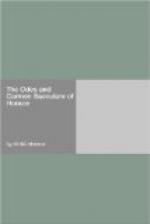The question, what metres should be selected, is of course one of very great difficulty. I can only explain what my own practice has been, with some of the reasons which have influenced me in particular cases. Perhaps we may take Milton’s celebrated translation of the Ode to Pyrrha as a starting point. There can be no doubt that to an English reader the metre chosen does give much of the effect of the original; yet the resemblance depends rather on the length of the respective lines than on any similarity in the cadences. But it is evident that he chose the iambic movement as the ordinary movement of English poetry; and it is evident, I think, that in translating Horace we shall be right in doing the same, as a general rule. Anapaestic and other rhythms may be beautiful and appropriate in themselves, but they cannot be manipulated so easily; the stanzas with which they are associated bear no resemblance, as stanzas, to the stanzas of Horace’s Odes. I have then followed Milton in appropriating the measure in question to the Latin metre, technically called the fourth Asclepiad, at the same time that I have substituted rhyme for blank verse, believing rhyme to be an inferior artist’s only chance of giving pleasure. There still remains a question about the distribution of the rhymes, which here, as in most other cases, I have chosen to make alternate. Successive rhymes have their advantages, but they do not give the effect of interlinking, which is so natural in a stanza; the quatrain is reduced to two couplets, and its unity is gone. From the fourth to the third Asclepiad the step is easy. Taking an English iambic line of ten syllables to represent the longer lines of the Latin, an English iambic line of six syllables to represent the shorter, we see that the metre of Horace’s “Scriberis Vario” finds its representative in the metre of Mr. Tennyson’s “Dream of Fair Women.” My experience would lead me to believe the English metre to be quite capable, in really skilful hands, of preserving the effect of the Latin, though, as I have said above, the Latin measure is employed by Horace both for a threnody and for a love-song.
The Sapphic and the Alcaic involve more difficult questions. Here, however, as in the Asclepiad, I believe we must be guided, to some extent, by external similarity. We must choose the iambic movement as being most congenial to English; we must avoid the ten-syllable iambic as already appropriated to the longer Asclepiad line. This leads me to conclude that the staple of each stanza should be the eight-syllable iambic, a measure more familiar to English lyric poetry than any other, and as such well adapted to represent the most familiar lyric measures of Horace. With regard to the Sapphic, it seems desirable that it should be represented by a measure of which the three first lines are eight-syllable iambics, the fourth some shorter variety. Of this stanza there are at least two kinds for which something might be said.




